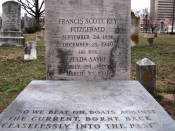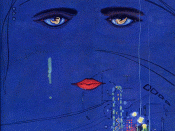The 1920s was a time of excess and growth. Economically, the 1920s was a time for great financial gain. Largely because of improvements in technology, productivity increased while overall production costs decreased, and the economy grew. Not only was this time filled with prosperity, but corruption as well. People finally acquired leisure time, and it was filled with gluttony and lust. Many authors during this time believed that society was living in excess and without curbing its appetite somewhat, ruin was just around the corner. Although most people associate good times and carefree abandon with the reverie of the 1920s, these authors also suggest a hidden, much darker side. Authors convey their belief that wealth and materialism corrupts the American dream during the Jazz Age by depicting the immorality through symbols.
In "The Great Gatsby", F. Scott Fitzgerald shows his disapproval of the times by portraying characters attempting to achieve their American dream by any means possible.
Myrtle Wilson, a low class inhabitant of the valley of ashes, puts her morals to the side when pursuing the wealthy life. Not even marriage stops Myrtle from having an affair with Tom Buchanan-- a rich man who enables her to finally buy the life she thinks she deserves. Not only does Myrtle cheat on her own husband, but she has an affair with someone who caught her eye with "a dress suit and patent leather shoes and [she] couldn't keep [her] eyes off him" (Fitzgerald 40) -- the ultimate symbol of success. It is not a love for Tom that attracted Myrtle, but his money and power that she lusts after. Jay Gatsby-- a man actually in love with Daisy Buchanan and not simply the money she represents-- aspires to achieve his dream of wealth in order to win the love...



Its good
But the title is wrong, calling it the Great Gatsby sets limits you clearly left, nothing wrong with that, but I'd like to know what title you turned it in with.
0 out of 0 people found this comment useful.